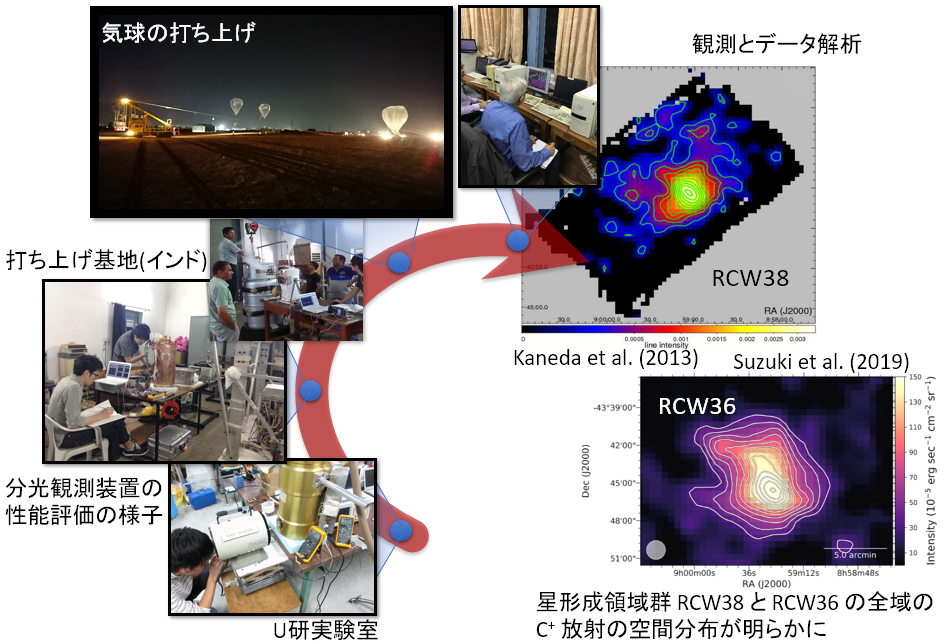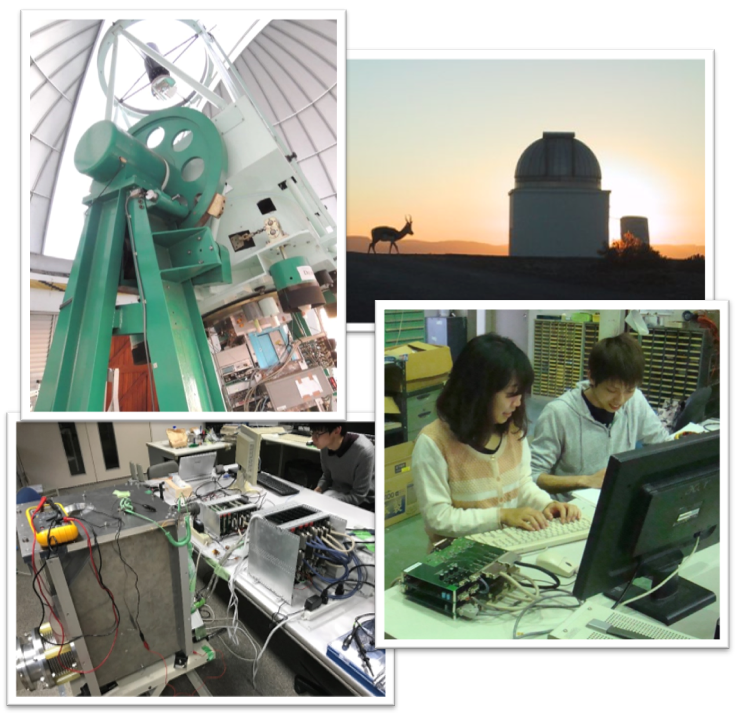Infrared astronomical satellite "AKARI"

Research with AKARI (credit partially to JAXA)
The infrared satellite "AKARI" with a 68-cm telescope cooled at 6 K was launched on Feb. 22 in 2006. Our Uir group led the development of one of the AKARI instruments, Far-Infrared Surveyor (FIS). We performed the all-sky survey in mid- and far-infrared in the first year and a half, and succeeded in making the infrared map of the Universe. AKARI was also used for the infrared imaging and spectroscopy for various targets. AKARI had the capability of near-infrared observations for abour 4 years even after the coolant, liquid helium, ran out. The all-sky mid-infrared map has been processed in our Uir lab. The AKARI survey data have long been used for the modern astronomy.
We actively analyze these data and study such as the formation process of planetary systems, nature of organic matters in the interstellar medium, evolution of galactic material, galaxy formation and evolution, and properties of massive black holes.
Related site:AInfrared astronomical satellite "AKARI" (JAXA)
Research topics
- Understanding the cycling of material in our Galaxy
- Investigation of the interstellar matter and its evolution in nearby galaxies
- Revealing the process of planet formation
- Exploration of dust-embedded Active Galactic Nuclei (AGN)
Next-generation space infrared astronomy mission "SPICA"

Development of an instrument for SPICA (credit partially to JAXA)
SPICA is a next-generation infrared astronomical satellite that will be launched in the late 2020s under the cooperation of Japan and Europe. The large 2.5-meter telescope is cooled down to 8 K, and it enables us to perform infrared spectroscopic observations with unprecedented high sensitivity and high wavelength resolution. SPICA will unveil the formation and evolution of galaxies, and birth of stars and planetary systems to ultimately understand how the Universe evolved to the present state with abundant material and various objects, harboring chemical complexitiy and life.
Our lab is leading the development of mid-infrared instrument (SMI) on-board the SPICA satellite in collaboration with JAXA/ISAS and universities (the university consortium). While studying the best science cases and conceptual design of SMI, we, including graduate students, are promoting the technology developments such as constructing an evaluation method of free-form surface mirrors in the cryogenic optical system, establishing the evaluation system of infrared detectors at cryogenic temperatures, and developing new far-infrared detectors.
Related web site: The Next-Generation Infrared Astronomy Mission "SPICA"
Research topics
- Development of evaluation methods of mid-infrared detectors
- Development of new far-infrared detectors
- Development of methods of optical experiments under ultralow temperatures
Balloon experiments in India

Balloon telescope experiments
Our lab has been conducting the balloon experiments in collaboration with ISAS/JAXA and Tata Institute of Fundamental Research in India (hereafter TIFR). The purpose of this experiment is to perform high angular resolution observations in far-infrared using the fabry-perot spectrometer (hereafter FPS) developed in Japan, that were installed in the balloon-borne, 1-m telescope constructed by the Indian group. More specifically, the physical conditions in the star-forming regions in our Milky Way galaxy are investigated by detecting emission from the ionized atomic carbon, [CII] fine-structure line at 157.74 micron.
The balloon flights have been carried out about once per year in Hyderabad in India. The first flight for the spectroscopy was made in 1999, and the far-infrared data were obtained for a wide region of Orion-A. The second flight was successfully performed in 2001, with the observations of Orion-A (M42, M43), Orion-B (NGC2024), and W3 regions. In 2008, the 6th flight was made and successful, and in 2009, the massive star-forming region RCW38 was observed. The flights in 2017 and 2018 were also successful and the data obtained for various star-forming restions have been analyzed. We have also developed the next generation spectrometer as well as a far-infrared detector for the balloon experiments.
Related web site: TATA Institute of Fundamental Research, Infrared and Optical Astronomy group
Research topics
- Development of new fabry-perot spectrometer
- Study of massive star formation using the [CII] emission
Ground-based telescope "IRSF"

IRSF 1.4m telescope, experiments in the lab
IRSF is a ground-based telescope with an aperture of 1.4 m located at Sutherland, South Africa. There are two major instruments: SIRIUS for simultaneous, three-bands imager in near-infrared and SIRPOL for near-infrared polarimetry. Those are powerful instruments to make wide-field observations of the Milky Way Galaxy as well as the Large and Small Magellanic Clouds.
Our laboratory has been working on the development of a new spectrometer for IRSF 1.4-m telescope. The advantage of this spectrometer is to simultaneously obtain the spectra both in optical (visible) and near-infrared, and such wide wavelength coverage is critical to understand the detailed physical condition for various astronomical objects. We plan to have the first light within a few years. Not only developing the new instrument, we also use the data already obtained with IRSF for scientific research. For example, the data with narrow-band filters are utilized to derive the abundance distribution in supernova remnants as well as galaxies.
Related web site: IRSF -- Infrared Survey Facility
Research topics
- Developing a new spectrometer
- Observations using narrow band filters